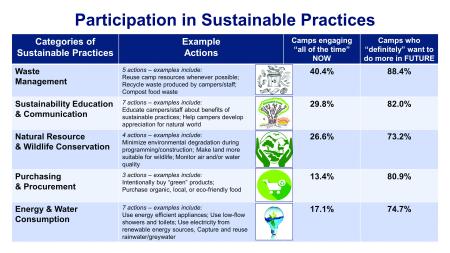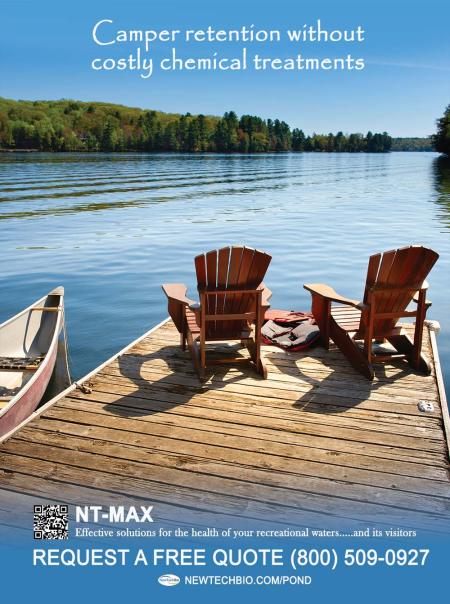Like many camp administrators around the country, Jeff Gamble wanted his camp his camp — Jefunira Camp in California — to “go green” and operate more sustainably. But he faced a challenge. The camp rents its site from the local school district. As he started working on his green needs assessment, Gamble realized he would have to ask the school administrator — a no-nonsense, business-oriented individual — difficult questions about energy rates, waste disposal, and other data that he, as a renter, didn’t have access to.
After a few weeks, Gamble worked up the nerve to mention Jefunira Camp’s efforts to green their program and facility. He was surprised when the administrator responded with great enthusiasm, and that initial interaction inspired an engaging conversation that continues today. According to Gamble, bringing up these sustainability goals “created an opportunity to form a very different type of relationship with the school district that, in a very competitive rental environment, further distinguished our program.” Knowing that Jefunira Camp was proactively looking for ways to minimize the use of natural resources and reduce utility costs was quite appealing to the school district. Ultimately, it has strengthened the camp’s relationship with the schools and helped them both work toward mutual sustainability goals.
Gamble’s story isn’t unique. Other camps that are exploring innovative approaches to build relationships by enhancing sustainability often find willing partners. Some camp organizations already work intentionally to integrate sustainability into their camp culture. Because the camp industry impacts millions of youth and adults each year, we have a great potential and obligation to model and reshape sustainable thinking and practices. But “going green” isn’t always easy. Many camps wonder what they can do and where to begin.
The Value of Enhancing Camp Sustainability
The trend toward sustainability is happening for multiple reasons. The cost of operating camps is rising, and many operations are searching for ways to become more efficient. Sustainable practices can help organizations cut long-term costs and save money. As global warming and other environmental changes threaten ecosystems around the world, pro-environmental behaviors that support natural resource conservation and stewardship are becoming more important. Camps that adopt sustainable practices contribute to these goals, reducing their ecological footprint and improving the planet’s health for present and future generations. Recognizing this, many parents now advocate for greener camp programs that embrace sustainability best practices and encourage children to enjoy and protect the natural environment. For example, a recent report from Green Camps found that 74 percent of parents agreed that camps should have fun programs that encourage children to protect our natural environment, and 52 percent said camps should minimize their environmental impact. These numbers suggest that an emphasis on sustainability can be good for marketing.
The push for sustainability is also coming from camp staff, board members, and the campers themselves. As one staff member from a camp that teaches campers sustainability noted, youth often ask, “How come we use Styrofoam if we are being taught to reduce waste? Why don’t we just stop?”
The staff member replied, “It’s hard to change the culture and convince the food service team to do more dishes,” highlighting one of the many challenges camp organizations face as they try to go green. Despite challenges, an emphasis on more sustainable practices can be the solution, whether your camp wants to:
- Save money
- Protect the environment
- Improve educational programming
- Build new partnerships
- Find new ways to access financial resources and upgrade facilities
So where does the camp world stand with respect to sustainability today?
A Study of Sustainability Practices in Camp Organizations across the United States
In 2021, a team led by Green Camps and partners at North Carolina State University, Clemson University, and the American Camp Association, conducted a study of camp organizations across the United States to understand what camps following sustainable practices are currently engaged in, what motivates camps to become more sustainable, and what barriers prevent camps from achieving sustainability goals. Respondents (mostly camp administrators) from 118 different organizations completed the survey, with at least one response from every US state. Most respondents were single-location camps (81 percent), and most respondents offered an overnight option (82 percent). Respondents represented a wide range of camp models: 35 percent of respondents were independent, nonprofit camps, 40 percent were affiliated, nonprofit camps (e.g., YMCA, Scouts), and 25 percent were for-profit organizations.
We identified sustainable practices across five broad categories and measured engagement in three to seven specific actions within each category (Figure 1). Listed in order of frequency, these categories were:
- Waste management (40 percent of camps engaging “all the time”)
- Sustainability education and communication (30 percent)
- Natural resource and wildlife conservation (27 percent)
- Energy and water consumption (17 percent)
- Purchasing and procurement (13 percent)
Most camp organizations that responded to the survey were somewhat interested (34 percent) or very interested (60 percent) in receiving more information about making camp operations more sustainable, with sustainability education and communication ranking as the highest future priority. Efforts to increase the sustainability of waste management and purchasing and procurement practices in the future were also a high priority for many organizations.

Figure 1. Current and desired future participation in a variety of sustainable practices reported by camp organizations across the United States.
Most camps reported they were motivated to engage in sustainable practices for environmental reasons (86 percent rated this as very important), followed by social (76 percent) and economic reasons (45 percent). As one respondent noted, “Our planet is on the verge of environmental collapse. Is there any other reason [to do this]? Without a healthy planet, nothing else matters.”
Another respondent highlighted the broader social impacts of a sustainable camp: “It is important to practice what we preach and set a good example for campers. We can easily teach them methods of conservation and sustainable practices that will have a wider impact on their home communities.”
And economic motivations were effectively summarized by a different respondent, who said, “Economic motivators are first priority because we need to stay open and continue to provide a great place for kids to spend the summer.”
We assessed 10 potential barriers to sustainability and found that lack of financial resources (noted as a major or moderate barrier by 79 percent of respondents) or technological resources (52 percent) were among the most significant constraints faced by camp organizations hoping to become more sustainable. One respondent remarked, “The biggest barrier is the perceived cost of implementing some of the bigger changes we need, like sustainable energy sources. Our leadership team is always open to making camps more ‘green,’ but it’s a business, and sometimes it is hard to do the right thing.”
The fact that many staff members lacked the knowledge and skills needed to implement sustainable practices was another commonly cited challenge. As one respondent said, “It’s hard getting all staff members on board with new practices.”
Many camps also chose to prioritize other issues over sustainability, with one admitting, “It’s hard to put sustainability at the top of a priority list that always seems like it’s ranked on immediate need and preventative planning.”
Most camps (65 percent) also reported that the COVID-19 pandemic made their efforts to prioritize sustainability more difficult. About one-third of camps indicated that “not knowing other organizations that might help” them achieve sustainability goals was a major barrier.
We observed a few differences in sustainable practices among various types of camps. In general, nonprofit camps affiliated with larger organizations were less likely to engage in sustainable practices than either for-profit or independent, nonprofit camps. Compared to rural camps, urban camps were more likely to engage in sustainability education as well as sustainable purchasing and procurement. Compared to day camps, overnight camps were more likely to engage in sustainability education and energy and water conservation. Sustainability efforts were not related to camp size. Nonprofit, affiliated camps were less likely than independent, nonprofit camps to rate environmental and social motivations for sustainability as important. Compared to other types of camps, for-profit camps were less likely to report lack of resources or other barriers to sustainability.
Overall, the results of our study suggest that many camp organizations across the United States are eager to embrace more sustainable practices, but their progress toward sustainability is often slow. Strategic assistance and improved communication and networking may be needed to help camps overcome resource constraints and realize their potential as sustainability leaders.
Recommendations for Camps “Going Green”
Although going green can be challenging, many resources are available to help camps committed to this process (Sudman, 2020). The following list highlights some suggestions to consider:
Start with a sustainability-needs assessment. A needs assessment can help you make informed decisions about where you might want to invest time and money and how to prioritize your efforts. While much of the information you’ll need to collect will come from administrators, take opportunities to invite staff and campers into the process. To help you establish a baseline and learn more about green action options, Green Camps is offering a free trial and access to a green survey to answer questions about energy, water, waste, and office conservation (focusing on many of the broader study categories already outlined). Learn more at community.greencamps.org.
Estimate cost savings and potential return on investment. Although you might be motivated to go green for environmental or social reasons, don’t overlook the economic benefits (and costs) of more sustainable operations. By understanding your baseline consumption of resources like energy, water, and food waste, you can more effectively calculate upfront costs and savings from the reduced use of those resources. In addition to informing decision-making, these estimates might also persuade others to support your organization’s sustainability initiatives.
Measure, track, and publicize impacts of your green actions. Measure and track the impact of your green actions to provide qualitative and quantitative information to highlight your organization’s sustainability efforts. This evidence can help you measure success and redirect efforts if necessary. Publicizing results of your efforts can attract positive attention and help you position your camp as a sustainability leader that models best practices and inspires change across the broader community.
Embrace innovative, sustainability-oriented programming. Each green action you take is an opportunity to create new programming to teach campers and staff about your sustainability efforts. Use these educational opportunities to your advantage to shape the way you interact with campers and staff and — ultimately — the way they interact with the natural environment.
Understand that teamwork makes the (sustainability) dream work. As the study results show, camps hoping to become more sustainable face numerous barriers, many of which are difficult to address alone. Seek assistance from outside organizations, such as Green Camps, which can help you build the capacity to achieve your sustainability goals. Assemble a team of key stakeholders from across your organization to begin or continue the conversation of what sustainability means and looks like at your camp. This will help to create a culture that embraces these new practices.
The sustainability journey can be daunting, but it’s less overwhelming when you have the support of your community, staff, campers, and everyone else who loves your camp!
Additional Resources
- Green Camps research page — greencamps.org/research — where you will find:
- Barriers and Motivators to Sustainability: Research Findings
- Journal of Outdoor Recreation Education and Leadership article
- 2020 Parent Research White Paper — Green Camps and Campfire
- “How to Increase Your Bottom Line by Going Green”: a 2011 report on how hotels and other hospitality organizations can improve efficiency by going green — yumpu.com/en/document/view/5989809/how-to-increase-your-bottom-line-by-going-green
- Camping Magazine article “Going Green at Camp” — ACAcamps.org/article/camping-magazine/going-green-camp
Be Part of the Green Movement
You and your camp can be part of this movement. If you are interested in beginning (or continuing) the journey to reaping the benefits of sustainability, visit greencamps.org to access the resources you need to get started.
Feel free to contact us if you have additional questions.
Danny Sudman spent 16 summers growing up at YMCA Camp Hanes in North Carolina — first as a camper and later as a camp counselor. After receiving his BA in Sociology from North Carolina State University, he went on to join the leadership team at Catalina Island Camps where he managed the challenge course program and served as an environmental educator. While on the island, he completed the Catalina Environmental Leadership Program, an initiative of Jean Michel Cousteau’s Ocean Futures Society. Danny founded Green Camps in 2014, believing 100 percent in the extraordinary ability of the camp community to inspire and develop the next generation of environmental leaders.
Lincoln Larson, PhD, is an associate professor in the Department of Parks, Recreation, & Tourism Management at NC State University. His conservation social science research and teaching focus on promoting sustainable human-environment interactions and fostering healthy relationships between people, parks, and nature.



